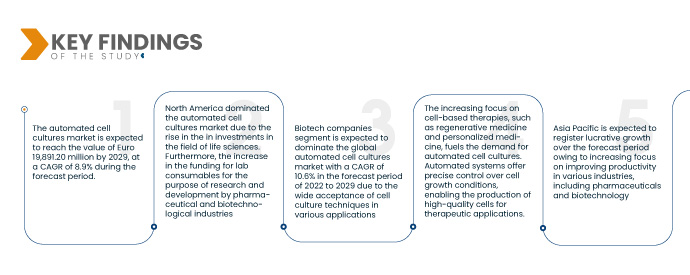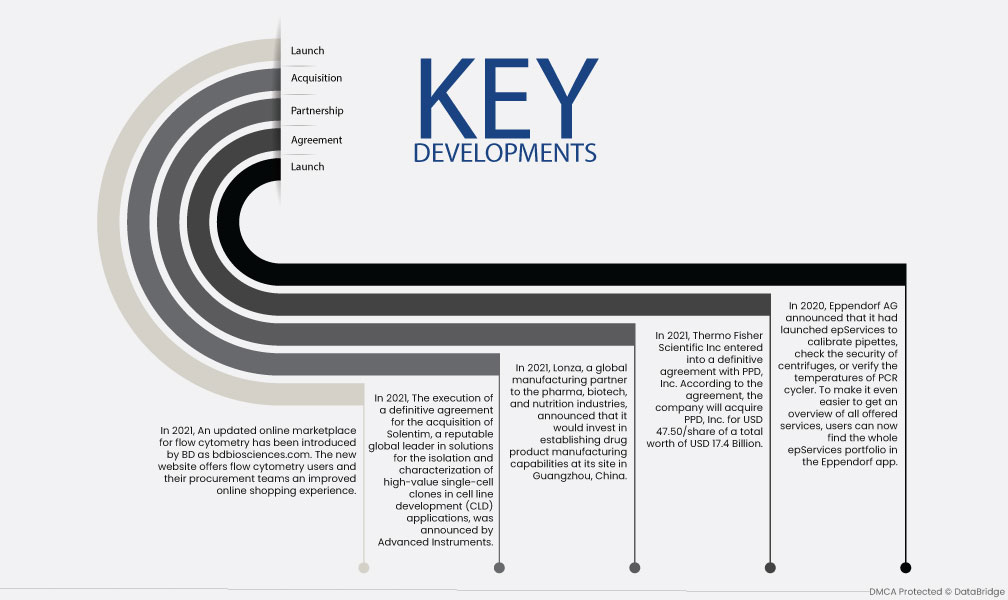자동화된 세포 배양 시장은 효율적이고 신뢰할 수 있는 세포 배양 및 분석을 제공할 수 있어 빠르게 성장하고 있습니다. 자동화는 처리량 증가, 재현성 향상, 그리고 배양 조건에 대한 정밀한 제어와 같은 이점을 제공합니다. 생명공학 연구의 발전과 세포 기반 치료법 및 신약 개발에 대한 수요 증가에 따라, 이 시장은 확장될 것으로 예상됩니다. 인공지능과 머신러닝의 통합은 이러한 시스템의 역량을 더욱 향상시켜 다양한 분야에서의 도입을 촉진하고 있습니다.
전체 보고서는 https://www.databridgemarketresearch.com/reports/global-automated-cell-cultures-market 에서 확인하세요.
데이터 브리지 마켓 리서치(Data Bridge Market Research)에 따르면, 자동 세포 배양 시장은 2029년까지 연평균 8.9%의 성장률을 기록하며 198억 9,120만 유로(약 2조 8,912억 원) 규모에 이를 것으로 예상됩니다. 생명공학 및 제약 연구 분야의 지속적인 발전은 자동 세포 배양 시스템에 대한 수요를 촉진하고 있습니다. 이러한 기술을 통해 연구자들은 프로세스를 간소화하고, 재현성을 향상시키며, 세포 배양 실험의 효율성을 높일 수 있습니다.
3D 세포 배양의 채택 증가로 시장 성장률이 촉진될 것으로 예상됩니다.
연구 및 신약 개발 분야에서 3D 세포 배양의 도입이 증가하는 것은 인체의 복잡한 세포 환경을 더 잘 모방할 수 있기 때문입니다. 신뢰성 있고 재현 가능한 3D 세포 배양 실험에 대한 수요를 충족하기 위해 자동화 시스템이 도입되고 있습니다. 이러한 시스템은 영양 공급, 산소 수준, 세포 파종과 같은 매개변수를 정밀하게 제어하여 3D 세포 배양 연구에서 일관되고 정확한 결과를 보장함으로써 자동화 세포 배양 시장 성장을 견인합니다.
보고서 범위 및 시장 세분화
보고서 메트릭
|
세부
|
예측 기간
|
2022년부터 2029년까지
|
기준 연도
|
2021
|
역사적인 해
|
2020 (2014-2019년으로 맞춤 설정 가능)
|
양적 단위
|
매출(백만 유로), 볼륨(단위), 가격(유로)
|
다루는 세그먼트
|
제품(소모품, 기기), 유형(무한 세포주 배양, 유한 세포주 배양), 응용 분야(약물 개발, 줄기세포 연구, 재생 의학, 암 연구, 백신, 기타), 최종 사용자(바이오텍 기업, 연구 기관, 학술 연구 기관, 기타)
|
포함 국가
|
미국, 북미의 캐나다 및 멕시코, 독일, 프랑스, 영국, 네덜란드, 스위스, 벨기에, 러시아, 이탈리아, 스페인, 터키, 유럽의 기타 유럽 국가, 중국, 일본, 인도, 한국, 싱가포르, 말레이시아, 호주, 태국, 인도네시아, 필리핀, 아시아 태평양(APAC)의 기타 아시아 태평양(APAC), 사우디아라비아, UAE, 남아프리카 공화국, 이집트, 이스라엘, 중동 및 아프리카(MEA)의 일부인 기타 중동 및 아프리카(MEA), 남미의 일부인 기타 남미 국가.
|
시장 참여자 포함
|
Sartorius AG(독일), Danaher(미국), Lonza(스위스), Nexcelom Bioscience LLC(미국), HiMedia Laboratories(인도), Cell Culture Company, LLC(미국), Advanced Instruments(미국), SHIBUYA CORPORATION(일본), NanoEntek(한국), FUJIFILM Holdings America Corporation(미국), Hitachi, Ltd.(미국), Kawasaki Heavy Industries, ltd.(일본), Sphere Fluidics Limited(영국), Thrive Bioscience(미국), Eppendorf AG(독일), CellGenix GmbH(독일), ChemoMetec(덴마크), PromoCell GmbH(독일), Thermo Fisher Scientific(미국), BioSpherix, Ltd.(미국), Merck KGaA(독일), Tecan Trading AG(스위스), Hamilton Company(미국), BD(미국), Benchmark scientific, Inc.(미국), Biotron Healthcare. (인도), RWD Life Science Co., LTD(미국), Corning Incorporated(미국), Bulldog-Bio.(미국), Sphere Fluidics Limited(영국)
|
보고서에서 다루는 데이터 포인트
|
Data Bridge Market Research에서 큐레이팅한 시장 보고서에는 시장 가치, 성장률, 세분화, 지리적 적용 범위, 주요 기업 등 시장 시나리오에 대한 통찰력 외에도 심층적인 전문가 분석, 환자 역학, 파이프라인 분석, 가격 분석, 규제 프레임워크가 포함됩니다.
|
세그먼트 분석:
자동 세포 배양 시장은 제품, 유형, 응용 분야 및 최종 사용자를 기준으로 세분화됩니다.
- 제품 기준으로 글로벌 자동 세포 배양 시장은 소모품과 장비로 구분됩니다. 소모품 부문은 소프트웨어 관련 구독료 또는 라이선스 비용 부담으로 인해 2022년부터 2029년까지 연평균 성장률 9.4%로 글로벌 자동 세포 배양 시장을 주도할 것으로 예상됩니다. 이 비용에는 업데이트, 유지 관리 및 고객 지원을 포함한 소프트웨어 솔루션 사용 및 접근 비용이 포함됩니다.
2022년에는 소모품 부문이 글로벌 자동 세포 배양 시장의 제품 부문을 지배할 것으로 예상됩니다.
2022년에는 백신 생산에 있어 세포 배양 기술에 대한 수요 증가로 소모품 부문이 글로벌 자동 세포 배양 시장을 주도할 것으로 예상됩니다. 또한, 세포 배양 기술의 발전과 자동화 시스템 도입 증가는 소모품 수요를 견인하고 있습니다. 따라서 소모품 부문은 2022년부터 2029년까지 예측 기간 동안 연평균 성장률 9.4%로 자동 세포 배양 시장에서 상당한 점유율을 차지할 것으로 예상됩니다.
- 글로벌 자동 세포 배양 시장은 유형별로 유한 세포주 배양과 무한 세포주 배양으로 구분됩니다. 무한 세포주 배양 부문은 세포 배양 기술 시스템의 기술 발전으로 인해 2022년부터 2029년까지 예측 기간 동안 연평균 성장률 9.5%로 글로벌 자동 세포 배양 시장을 주도할 것으로 예상됩니다.
- 글로벌 자동 세포 배양 시장은 응용 분야별로 약물 개발, 줄기세포 연구, 재생 의학, 암 연구, 백신 등으로 구분됩니다. 약물 개발 부문은 정부의 우호적인 정책에 힘입어 2022년부터 2029년까지 연평균 성장률 8.4%로 글로벌 자동 세포 배양 시장을 주도할 것으로 예상됩니다.
2022년에는 약물 개발 부문이 글로벌 자동화 세포 배양 시장의 응용 부문을 지배할 것으로 예상됩니다.
2022년에는 약물 개발 부문이 정부의 호의적인 정책과 제약 산업에서 약물 스크리닝, 독성 테스트, 효능 평가를 위한 자동 세포 배양 시스템의 광범위한 사용에 힘입어 글로벌 자동 세포 배양 시장을 장악할 것으로 예상되며, 2022년부터 2029년까지의 예측 기간 동안 연평균 성장률은 8.4%가 될 것입니다.
- 최종 사용자 기준으로 글로벌 자동 세포 배양 시장은 생명공학 기업, 연구 기관, 학술 연구 기관 등으로 세분화됩니다. 생명공학 기업 부문은 의료 및 과학 목적의 생명공학 연구, 개발 및 제품 생산에 참여하는 상업 기관으로 인해 2022년부터 2029년까지 예측 기간 동안 연평균 성장률 10.6%로 글로벌 자동 세포 배양 시장을 주도할 것으로 예상됩니다.
주요 플레이어
Data Bridge Market Research에서는 자동 세포 배양 시장의 주요 자동 세포 배양 기업으로 Sartorius AG(독일), Danaher(미국), Lonza(스위스), Nexcelom Bioscience LLC(미국), HiMedia Laboratories(인도), Cell Culture Company, LLC(미국), Advanced Instruments(미국), SHIBUYA CORPORATION(일본), NanoEntek(한국), FUJIFILM Holdings America Corporation(미국), Hitachi, Ltd.(미국)를 꼽았습니다.
시장 개발
- 2021년, BD는 유세포분석기를 위한 업데이트된 온라인 마켓플레이스인 bdbiosciences.com을 출시했습니다. 이 새로운 웹사이트는 유세포분석기 사용자와 구매팀에게 향상된 온라인 쇼핑 경험을 제공합니다.
- Advanced Instruments는 2021년에 세포주 개발(CLD) 분야에서 고가치 단일 세포 클론의 분리 및 특성화 솔루션 분야에서 명성 있는 글로벌 리더인 Solentim을 인수하기 위한 최종 계약 체결을 발표했습니다.
- 2021년, 제약, 바이오테크, 영양 산업의 글로벌 제조 파트너인 론자는 중국 광저우에 있는 자사 공장에 의약품 제조 역량을 구축하기 위해 투자할 것이라고 발표했습니다.
- 2021년 Thermo Fisher Scientific Inc.는 PPD, Inc.와 최종 계약을 체결했습니다. 이 계약에 따라 Thermo Fisher Scientific Inc.는 PPD, Inc.를 주당 47.50달러에 인수하며, 총 인수 금액은 174억 달러입니다.
- 2020년, Eppendorf AG는 피펫 교정, 원심분리기 안전 점검, PCR 사이클러 온도 확인을 위한 epServices를 출시했다고 발표했습니다. 제공되는 모든 서비스를 더욱 쉽게 살펴보실 수 있도록, 이제 Eppendorf 앱에서 전체 epServices 포트폴리오를 확인하실 수 있습니다.
지역 분석
지리적으로, 자동화 세포 배양 시장 보고서에서 다루는 국가는 북미의 미국, 캐나다 및 멕시코, 독일, 프랑스, 영국, 네덜란드, 스위스, 벨기에, 러시아, 이탈리아, 스페인, 터키, 유럽의 기타 유럽, 중국, 일본, 인도, 한국, 싱가포르, 말레이시아, 호주, 태국, 인도네시아, 필리핀, 아시아 태평양(APAC)의 기타 아시아 태평양(APAC), 사우디 아라비아, UAE, 남아프리카 공화국, 이집트, 이스라엘, 중동 및 아프리카(MEA)의 일부인 기타 중동 및 아프리카(MEA), 브라질, 아르헨티나, 남미의 일부인 기타 남미입니다.
Data Bridge Market Research 분석에 따르면:
북미는 2022년부터 2029년까지의 예측 기간 동안 자동화 세포 배양 시장 에서 지배적인 지역입니다.
북미 지역이 자동 세포 배양 시장에서 우위를 점하는 것은 생명 과학 분야에 대한 상당한 투자 덕분입니다. 이 지역의 제약 및 생명공학 산업은 특히 연구 개발 목적의 실험실 소모품에 대한 투자를 늘리고 있습니다. 이러한 상당한 투자와 자동 세포 배양 시스템 수요 증가는 예측 기간 동안 북미 시장 성장을 견인할 것으로 예상됩니다.
아시아 태평양 지역은 2022년부터 2029년까지 자동화 세포 배양 시장에서 가장 빠르게 성장하는 지역으로 추정됩니다.
아시아 태평양 지역은 예측 기간 동안 자동 세포 배양 시장에서 상당한 성장을 경험할 것으로 예상됩니다. 이러한 성장은 제약 및 생명공학을 포함한 다양한 산업의 생산성 향상에 대한 아시아 태평양 지역의 집중적인 관심에 기인합니다. 자동 세포 배양 시스템 도입은 처리량과 효율성을 높여 생산성을 향상시킵니다. 결과적으로 아시아 태평양 지역의 자동 세포 배양 수요는 향후 몇 년 동안 크게 증가할 것으로 예상됩니다.
자동 세포 배양 시장 보고서 에 대한 자세한 내용은 여기를 클릭하세요 - https://www.databridgemarketresearch.com/reports/global-automated-cell-cultures-market












